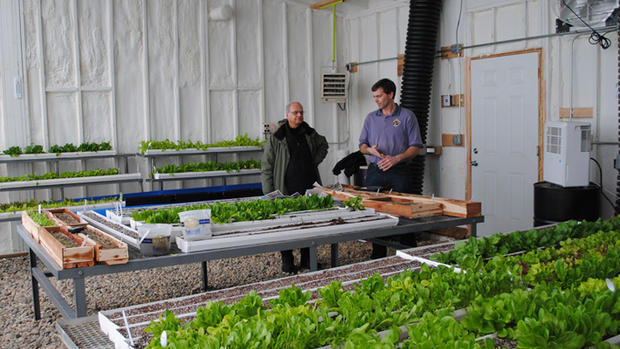NEW LONDON — What may be the best classroom ever built comes with a floor of stones, NLS greenhousewelded furniture and plenty of dirt. What the students of the New London-Spicer High School learn in their new, passive solar greenhouse could matter to all of Kandiyohi County. Arvind Auluck-Wilson’s motivation in helping design the greenhouse is to jump-start a new industry in the county. The owner of Energy Technology Innovations in Milan believes that entrepreneurs in the county could build similar greenhouses to raise fresh greens for sale through the winter. But education comes first: “This is one big science experiment,” said Tracy Tebben, NLS’ agriculture instructor, who helped spearhead the greenhouse project. Tebben and Auluck-Wilson will be welcoming the public to tour the greenhouse during an open house from 1-6 p.m. Friday at the high school. The 30-foot-by-24-foot greenhouse represents the latest evolution in the design of passive solar greenhouses. The goal is to tap the energy of the sun to warm the greenhouses in the winter and keep the use of fossil fuel at a minimum. For Auluck-Wilson, the greenhouse can help answer important questions about the economic viability of deep winter production. From an educational standpoint, Tebben said the greenhouse offers students opportunities to learn about everything from physics and the biology of raising plants to agricultural marketing, aqua-culture and hydro-phonics. There’s no question the students have been enjoying the hands-on opportunities found in the classroom. “Would you rather learn about growing plants out of a textbook or get your hands dirty and come out here and do it?” Tebben asked rhetorically. He is a 19-year veteran of the NLS faculty. He called on some of his former graduates to help build the greenhouse last summer. The volunteers excavated a 4-foot deep pit under what is now the greenhouse. They insulated its walls and floor, and ran a pipe along the frost line to tap the geo-thermal heat of the underground. They filled the pit with pea-sized rock. Air heated by the sun in the greenhouse is circulated through the stones, warming them. The stones give up their heat at night. The greenhouse is well-insulated, and a spacious, unheated storage area is part of its north side. It serves as a windbreak to the greenhouse. Tebben called on his ag students to weld the metal tables that hold the greenhouse plants at waist height; it makes tending them easy. Students are raising a selection of cool weather greens. There’s also an area where students are raising plants hydrophonically. Tebben and Aulick-Wilson said they hope to incorporate aqua-culture next year, possibly by raising perch. All of the component parts of the greenhouse are items that can readily be purchased at local farm or home-building stores. It is purposely built with “off the shelf technology” so that anyone can affordably build their own copies of it, explained Auluck-Wilson. He is excited about the micro-enterprise possibilities that passive solar greenhouses represent. For roughly the price of an SUV, it’s possible to open a business, he noted. This greenhouse is a worthy model to copy. Everything from the diameter of the pipes circulating the air to the orientation of the structure was engineered to maximize its efficiency. The insulated, polycarbonate panes that allow the sun’s energy into the greenhouse are sloped at a 60-degree angle, thanks to the advice of Willmar architect Richard Engan. The alignment maximizes the solar radiation received on Jan. 20 of each year. On average this is the coldest day of the year, and consequently when it is most important to take advantage of the available solar radiation. An electric, milk house style heater kicks in whenever the greenhouse is not able to keep temperatures safely above freezing. The school also erected a vertical axis, small wind turbine on the site. The three-kilowatt capacity generator feeds its power into the electrical grid. Over the course of a year, it is projected to produce more electricity than the greenhouse consumes. The project was all made possible thanks to lots of local support, grants and the labor of former and current students, said Tebben. He was successful in obtaining significant grant assistance for the project, which kept the school’s costs very modest. This project was not without its frustrations. The turbine was built in Taiwan, where the metric system is used. The tower was built in Minnesota, where the English system of measurement remains in use. Someone failed to correctly calculate the conversions needed. With a crane on site, it was discovered that things did not line up. “It was worth mentioning not everybody was happy,” said Auluck-Wilson. A coupling was built to rectify the problem, and the crane and its operator returned for a second time, gratis.

